
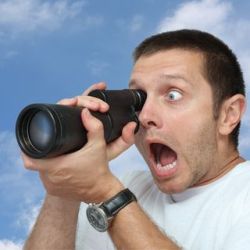 Have you ever discovered a telescope eyepiece in the pocket of your pajamas? Have you ever measured your roof for a dome? Do you know how to pronounce Cassiopeia? If so, you may have wondered, “is there hope for someone like me?” The answer is no. But you can help others learn the basics of telescopology.
Have you ever discovered a telescope eyepiece in the pocket of your pajamas? Have you ever measured your roof for a dome? Do you know how to pronounce Cassiopeia? If so, you may have wondered, “is there hope for someone like me?” The answer is no. But you can help others learn the basics of telescopology.
1. How powerful is it?
This is the first thing you want to ask a star hopper if you truly seek to annoy them. Then quickly follow up with “How far can it see?” and then “Why don’t any of the Big Dipper stars ever shoot?” It helps to have a friend stand back a few paces until the scope jockey gets done with a long rehearsed speech about how telescopes work. Then the friend should step forward and ask “What’s with the big microscope?”
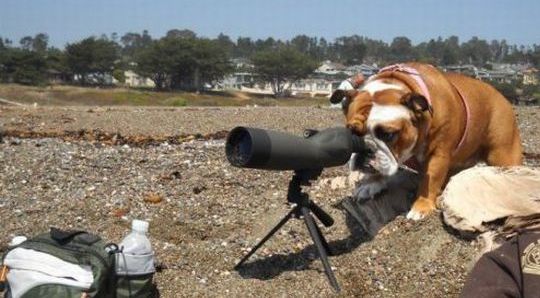
Magnification is not as important as it seems. Neither is it meaningful to ask how far away you can see. What is important and meaningful are these three things:
How dim of a thing can I see? (light-gathering)
How detailed is the image? (resolution)
How much did it cost? (spouse compliance)
The answer to the first two questions is given by the size of the objective (the main optical element). Whether it is a lens or a mirror, the width of the objective is the most important consideration. And either way, bigger is better. The third question is trickier and may depend on which state you filed for divorce in.
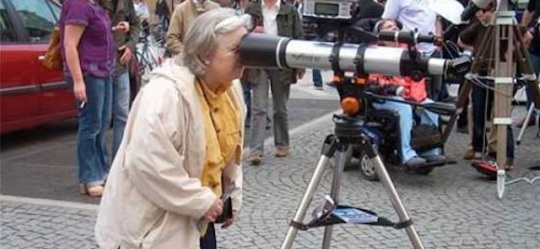
So here’s the real question, “Is it true what they say about the size of your objective?”
Light Gathering
Generally speaking, the bigger the objective, the dimmer stuff you will be able to see, and some of the coolest stuff is pretty dim. No matter how clever the design, a telescope can only work with the light that is captured. So bigger is better.
Resolution
Higher resolution means an image with more detail. In modern lingo, it means Hi-Def. Other factors affect resolution but the maximum resolving power is just physics. So bigger is better.
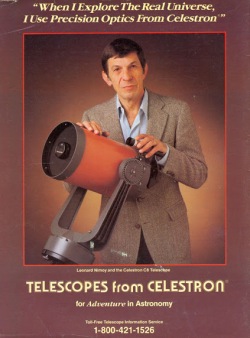 2. Which telescope should I buy?
2. Which telescope should I buy?
“Little Johnny or Julie or whatever has shown some interest in astrology so I want to get them a telescope for Christmas but they might not stay interested so I only want to spend five dollars but I want to get a really good one.”
Binoculars
First telescope? Consider binoculars. They are an important tool used by pretty much every hard core star hopper you will ever meet. Some stuff out there in space doesn’t fit into the highly magnified view of a telescope and thus is more appropriately viewed in binoculars. Also, binoculars are used to “pre-locate” objects before attempting to aim telescopes at them. There are other reasons to buy binoculars first. They can be used for many purposes such as sports, birds, planes, neighbors, and so forth. And finally, binoculars will allow you to cheaply find out if you have a little Galileo on your hands. That said, Johnny or Julie or whatever knows the difference between binoculars and a telescope and they wanted the damn telescope and now they hate you for life.
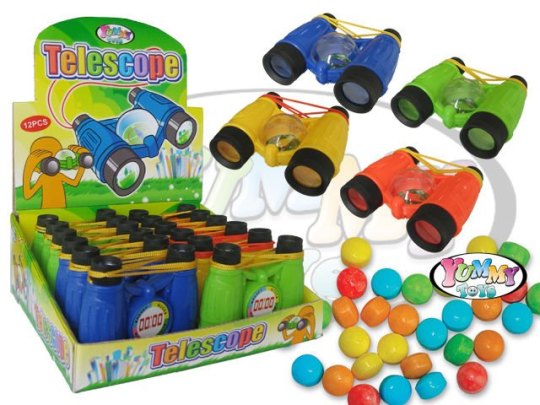
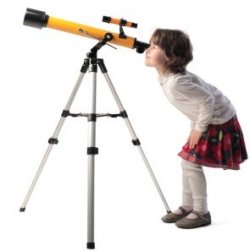 Cheap Refractors
Cheap Refractors
There are so-called “dime store” telescopes that have objective lenses in the 30 to 60 millimeter range. They are priced from $50 to $150,000,000,000. The optics tend to be of low quality. Some even have optics that are made of plastic instead of glass. The mounts are wobbly, as are their users. The package includes an eyepiece capable of producing magnification far in excess of the Hubble. This meaningless theoretical magnification is sometimes shamelessly used as an advertising ploy. Remember that when you go to re-sell it.
High Quality Refractors
Refractors use lenses which have several design advantages. Unlike their dime-store counterparts, quality refractors tend to provide images that are as beautiful as the most demanding purist could ever require. You get stars concentrated into tiny pinpoints, as they should be, and the background sky is very black. Even the most shy of planets will reveal their lovely surface details once they realize how elegantly you’ve designed your telescope.

One of the drawbacks with refractors is that different colors refract at different angles, making it difficult to bring all the colors of an image to the same focus. In the simpler, cheaper models the stars can be focused for blue, giving a fuzzy red halo, or focused for red, giving a fuzzy blue halo. That’s messed up. This problem is mitigated in the more expensive models by the addition of more complicated and fancy-ass lens elements.
Reflectors
Reflecting telescopes gather and focus light by reflecting it off of the surface of a curved mirror. Many of the reflectors in use today are Newtonians, so called because they are based on a design that was invented by Isaac Newton, right after he invented gravity.
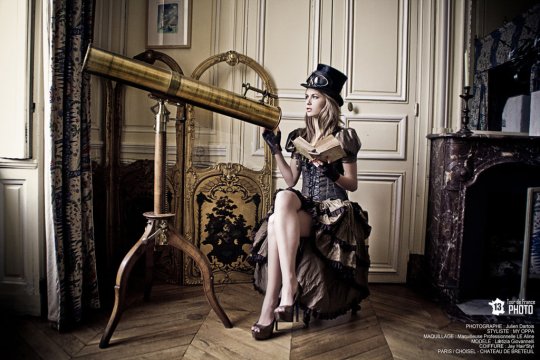
With a basic reflector, light enters the tube, reflects off a mirror at the bottom, goes back up to a second mirror held in the middle of the tube at an angle, and then out through a hole in the side to the eyepiece. It’s a lot of bouncing around but light never gets tired and since it’s done with mirrors, all the colors come to the same focus.
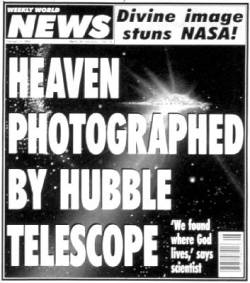 One problem with Newton’s design is that the curve of the mirror has to be in the shape of a parabola. That’s a shape that even Newton found easier to describe mathematically than to produce in real life. It requires some skill but many people of all ages successfully grind, polish, and parabolize their own mirrors for constructing their own telescopes. It gives them a little joy in an otherwise terrifying world so please don’t make fun of them.
One problem with Newton’s design is that the curve of the mirror has to be in the shape of a parabola. That’s a shape that even Newton found easier to describe mathematically than to produce in real life. It requires some skill but many people of all ages successfully grind, polish, and parabolize their own mirrors for constructing their own telescopes. It gives them a little joy in an otherwise terrifying world so please don’t make fun of them.
Schmidt Cassegrains
The Schmidt Cassegrain design is similar to the Newtonian described above but uses a combination of lenses and mirrors, thus insuring the disadvantages of both. Another difference is that instead of the secondary mirror reflecting the light out at an angle, it sends the light right back down the tube and out through a hole drilled in the center of the primary mirror. Drilling holes in telescope mirrors is called “trepanning” which is a term that also refers to drilling holes in a skull. I’ll let you make up your own joke about how these things are connected.
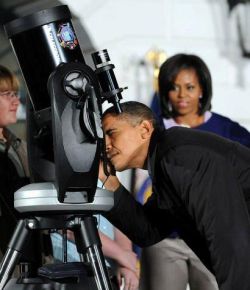 One advantage of the Cassegrain doughnut hole design is that the viewer gets to stand on the ground instead of on a ladder. With the very popular Schmidt design of Cassegrain, the front of the tube is covered with a magical lens that compensates for the primary mirror not being parabolized. The beauty of this tactic is a very long optical path in a portable package that will fit in your apartment. Their compacted-ness also makes for a relatively stable platform for astrophotography. Many models now come computerized so you don’t even have to learn anything icky like reading star maps.
One advantage of the Cassegrain doughnut hole design is that the viewer gets to stand on the ground instead of on a ladder. With the very popular Schmidt design of Cassegrain, the front of the tube is covered with a magical lens that compensates for the primary mirror not being parabolized. The beauty of this tactic is a very long optical path in a portable package that will fit in your apartment. Their compacted-ness also makes for a relatively stable platform for astrophotography. Many models now come computerized so you don’t even have to learn anything icky like reading star maps.
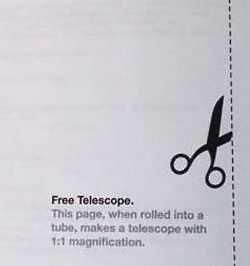 3. What about the mount?
3. What about the mount?
A telescope is just no fun without a stable, easy-to-use mount. You will appreciate a mount that allows you to move the scope smoothly, instead of in a herky jerky motion. Don’t expect the business end of the scope to glide like a Cadillac when the back end is bouncing around like a Jeep. It is very difficult to center an object in the field of view with a poor mount.
The motion of the turning Earth quickly moves objects out of view from the eyepiece, especially objects near the celestial equator. Many mounts are designed to compensate for this motion. They utilize accessories such as “clock drives” that automatically move the scope at the appropriate rate. These techniques (and others) are very important for photography.
Most equatorial mounts in use by amateurs are one of two types: german equatorial mounts (gem’s) and fork mounts.

German mounts are good but nein ver ja fingapoken und mittengrabben. Ist easy ver breakin das springenverks, mit snappinfusen und loudish spitzensparken. Ist nein ver werken by das dumkopfen. Das rubbernecken sightseers musten relaxen und jest watchen das blinkenlights.
Fork mounts are shaped like big forks.
Each type of mount has its proponents and opponents but the overall popularity shows that both are very capable mounts.

Dobsonian Mounts
Expensive equatorial mounts and clock drives are not at all necessary for dedicated observing. Many amateur astronomers use simple altitude-azimuth type mounts. These mounts allow you to move the scope up and down and around in a circle. And let’s face it, isn’t that what it’s really all about? You just do the hokey-pokey and you spin your shit around. So for your first scope, consider the stable and elegantly simple Dobsonian mount, made popular by John Dobson, who was popular. As John once told me,
“Newtonian Schmootonian”
“Cassegrain Schmassegrain”
“Schmidt, Schmidt.”
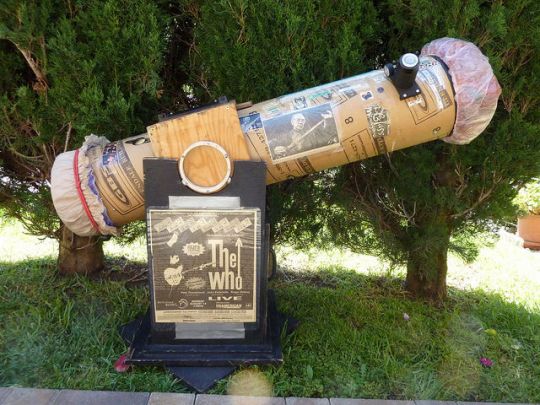
4. What accessories do I need?
The telescope industry will never get tired of providing you with ways to spend money. The standard basic gear includes:
- A red light, to protect your dark adaption and freak out the neighbors.
- Star charts, which include “deep sky” objects because you’ll get tired of looking at the Moon. And the neighbors.
- Binoculars, 7×35 or 7×50, or maybe even 8×50.
- A case for hauling all your crap outside and back.
- Notebooks and pencils so people will think you know what you are doing.
- Warm clothing, perhaps including gloves without fingers.
- Thermos and mug for your favorite beverage.
- Warm friends.
How many eyepieces do you need? At least three; low, medium, and high power. How many do you think you need? A few more than will fit in the travel case you have to keep them in. Regardless, the most important accessory is the eyepiece. Remember, this is the last thing that happens to the light before it enters your eye and gets completely distorted by your brain. You know how excellent stereo speakers can make an average audio system sound good, so an excellent eyepiece will do wonders for your telescope. Spend lots of money for quality eyepieces.
Low power is used for initially locating difficult objects, and for viewing very large objects. Medium power is what you will likely use most often; medium is your friend. Medium is the one you will find in your pajamas. Since the medium one is so useful, buy it first. High power is mostly only used on nights when the sky is extremely calm and clear and now that you bought a telescope that’s never going to happen anyway.

Other Accessories
If you bought a telescope bundled with accessories it probably came with something called a Barlow. It is designed to increase magnification by totally destroying the quality of the image. It fits between the focuser and the eyepiece and it also fits nicely in your sock drawer where it belongs. But first use it once with your most powerful eyepiece to see just how awful an image can be. Actually there are circumstances where it can be useful, like improving the ability of a short guide scope during long exposure photography. It can also be used with a low power eyepiece to make it high power, while retaining the longer eye relief (eyepiece-to-eyeball separation) of the low power eyepiece. This is handy if you wear glasses while viewing. But better still, take off your damn glasses and refocus the scope to your eye.
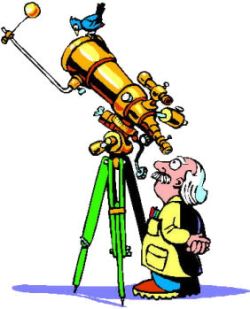 Filters are available to enhance images. Most of them screw onto an eyepiece barrel. Some are designed to increase the contrast for certain objects such as nebulae or planets. There are polarizers which are nice for the Moon. There are also full-aperture solar filters which cover the entire front end of the scope and allow you to safely view the Sun. Remember to remove or cover up your finder scope while aimed at the Sun or it will heat up and melt and smell terrible. True story.
Filters are available to enhance images. Most of them screw onto an eyepiece barrel. Some are designed to increase the contrast for certain objects such as nebulae or planets. There are polarizers which are nice for the Moon. There are also full-aperture solar filters which cover the entire front end of the scope and allow you to safely view the Sun. Remember to remove or cover up your finder scope while aimed at the Sun or it will heat up and melt and smell terrible. True story.
Carpe Noctem

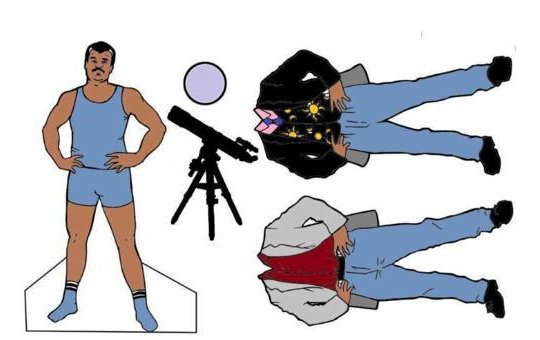





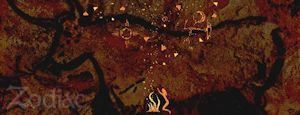


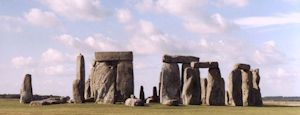



February 15, 2015
Astronomy, Technology